Bulletin – March 2009 Japanese Retail Investors and the Carry Trade[1]
- Download 256KB
Introduction
The carry trade has been an important source of flows in foreign exchange markets in recent years. While a carry trade is difficult to define precisely, it generally involves borrowing money in a low-yielding currency and investing in a high-yielding currency; that is, taking a leveraged position on the interest differential between two markets. Total returns of such a strategy can vary widely depending on exchange rate movements. During the period of relatively low volatility in exchange rates from 2003 to 2007, carry trades were highly profitable, with exchange rate movements between important carry trade currency pairs often working to increase returns, such as the appreciation of the Australian and New Zealand dollars against the Japanese yen (Cairns, Ho and McCauley 2007). As a result, the strategy became increasingly popular among a wide range of investors. However, the recent sharp depreciation in high-yielding currencies has eroded carry trade returns and been associated with a rapid unwinding of these positions.
Despite the importance of carry trade strategies, it is difficult to obtain direct information on the size of carry trade positions (Galati, Heath and McGuire 2007). In this article we examine the behaviour of two groups of investors for which detailed data on foreign exchange positions are available: Japanese retail investors using online margin accounts, the focus of the article, and ‘speculative’ traders on the Chicago Mercantile Exchange (CME). The analysis supports the anecdotal evidence that Japanese retail investors predominantly follow carry trade strategies – that is, their foreign currency positions are primarily motivated by interest rate differentials. Speculative investors on the CME, while also attempting to benefit from the positive interest rate differential on carry trade positions, appear to combine carry trade strategies with positions designed to take advantage of the momentum in exchange rate movements. Although the aggregate carry trade profits for Japanese retail investors were positive for a number of years prior to the depreciation of the Australian dollar in 2008, as a group Japanese retail margin account investors held large positions and thus made large losses when carry trade returns turned sharply negative during the financial crisis. In contrast, CME speculative traders suffered less severe carry trade losses as they responded more quickly to the turning points in exchange rates.
Carry Trade Returns
The ability to obtain positive returns from a carry trade strategy relies on the failure of uncovered interest parity (UIP). In particular, UIP is an equilibrium condition that states that investors expect nominal exchange rates will move to offset the interest differential across economies, so that they are indifferent between holding the two currencies. In practice, the existence of positive carry trade returns over extended periods shows that UIP does not always hold, particularly over short horizons. For example, the simple carry trade of taking a long position in the Australian dollar against the yen was highly profitable between 2003 and 2007. Rather than depreciating to offset the interest differential, the higher-yielding Australian dollar consistently appreciated against the yen over this period (Graph 1). However, the returns that were steadily built up over this period were largely eliminated by the sharp depreciation of the Australian dollar in 2008. This is consistent with the finding of Chinn and Meredith (2004) that there is much more support for UIP at long horizons for the G7 economies than is found in most studies relying on short-horizon data.
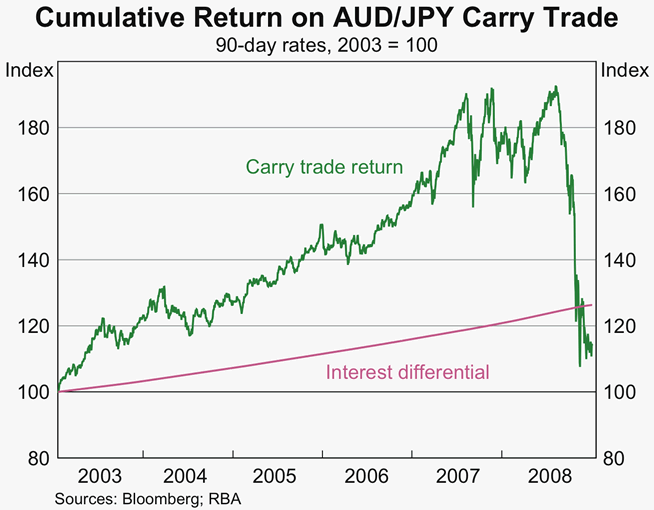
A slightly different interpretation of the carry trade is that investors earn a risk premium for holding assets denominated in a ‘risky’ currency – defined as one that occasionally suffers sudden and large depreciations. Carry trade investors are essentially taking a bet against UIP over the horizon of their investment. For much of the last five years carry trades have paid off, but when they have not the losses have been large because the investment currency has depreciated sharply. This is consistent with the pattern of returns documented in Brunnermeier, Nagel and Pedersen (2008). Whether investors make a profit in the long run depends on how well they time the establishment and closure of carry trade positions. The final section of this article considers how the timing of trades has affected the relative profitability of Japanese retail investors and CME speculative traders over the past few years.
Japanese Retail Foreign Exchange Investors
Individual Japanese retail foreign exchange investors take small positions but collectively have accounted for an increasingly significant share of foreign exchange market activity in recent years. Retail investors in Japan are naturally attracted to the carry trade because of the low returns on Japanese domestic savings. Markets have developed to allow Japanese households to obtain exposure to cross-country interest differentials through a variety of mechanisms, including investing in locally marketed high-yielding foreign currency assets, such as uridashi bonds, or by trading on foreign exchange margin accounts. Although investments in these two instruments are similar in many respects, there are two significant differences: only the margin account positions can be easily liquidated; and margin account positions are leveraged, whereas foreign currency bonds may not be.
Financial institutions have established so-called ‘retail aggregators’ to offer Japanese households sophisticated online margin accounts that allow the investor to take leveraged positions in major currencies against the yen. The retail investor can choose to go long or short one or more of these currencies. If the position is held open overnight, the aggregator pays the investor the interest rate differential on the currency pair (typically a positive differential on a short yen position).
The increase in activity in these accounts has been responsible for an increasingly large share of turnover in the foreign exchange market over the past few years. Daily average turnover of Japanese foreign exchange margin trading was almost US$70 billion in the September quarter 2008, equivalent to around 20 per cent of total turnover in the Japanese foreign exchange market (Graph 2). This represents a rapid increase from turnover of less than US$10 billion two years earlier. Up until September 2008, growth in turnover was driven by an increase in the number of accounts, which more than offset declines in the average deposit size and level of leverage. Terada, Higashio and Iwasaki (2008) report that the average deposit was around US$14,000 in March 2008 and that average leverage for investors had fallen from 8½ times in early 2007 to around 6 times. More recently, anecdotal evidence suggests growth in turnover has been associated with the unwinding of existing carry trades and a reduction in the number and size of retail investor positions.
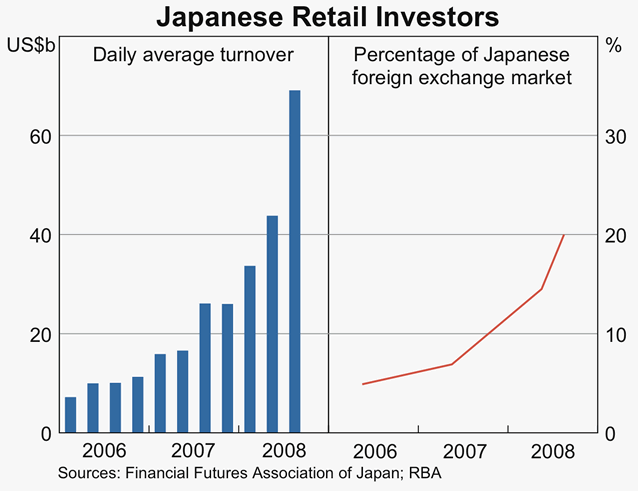
Given the size of the Japanese foreign exchange market, Japanese retail investors also account for a notable proportion of global turnover in individual currency pairs. For Australian dollar, pound sterling and New Zealand dollar turnover against the yen, Japanese retail investors' activity is equivalent to around 5 per cent of global turnover (Graph 3).
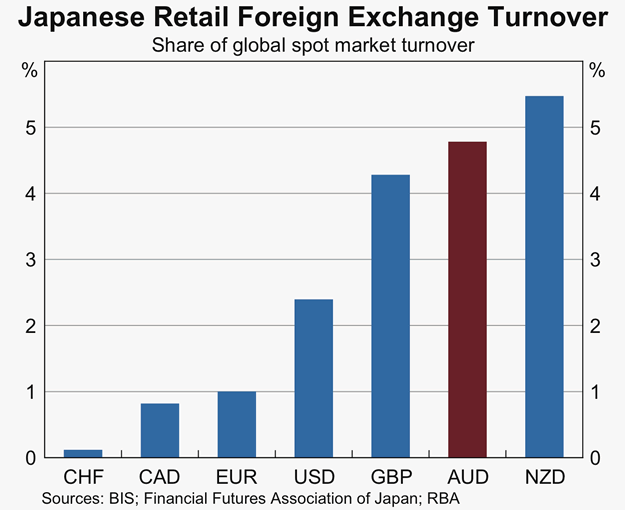
Although anecdotal evidence suggests Japanese retail investors predominantly follow strategies based on the carry trade, there is little direct evidence about how they react to exchange rate movements or changes in interest rates – the two main factors that affect the profitability of the carry trade strategy. This article presents graphical analysis, which has been confirmed by econometric analysis, of the behaviour of this increasingly significant class of foreign exchange investor. The analysis makes use of a dataset from the Tokyo Financial Exchange (TFX) on the net currency positions of Japanese retail investors. The data provide the long and short positions of Japanese retail investors trading in seven currency pairs against the yen and cover around 10 per cent of foreign exchange margin turnover in Japan. The TFX data make it possible to identify the reaction of investors to changes in interest rate differentials, exchange rate movements and financial market volatility.
Behaviour of Japanese Retail Investors
The data on aggregate positions for Japanese investors using online margin accounts show that in recent years these investors have typically held sizable long positions in foreign currencies against short positions in yen (Graph 4). The level of long foreign currency positions peaked in August 2007 at US$45 billion, after doubling over June and July. Following the sharp depreciation of a number of high-yielding currencies and a pick-up in volatility at the onset of the financial crisis in August 2007, long positions were quickly liquidated and the value of these positions fell to US$20 billion. Long positions were then rebuilt over the year to August 2008. However, with another episode of market turbulence and sharp cuts in global policy interest rates, Japanese retail investors again sharply reduced their long foreign currency positions in September and October 2008. Short positions were also reduced at this time, suggesting that an increase in uncertainty and margin call liquidations were important factors.
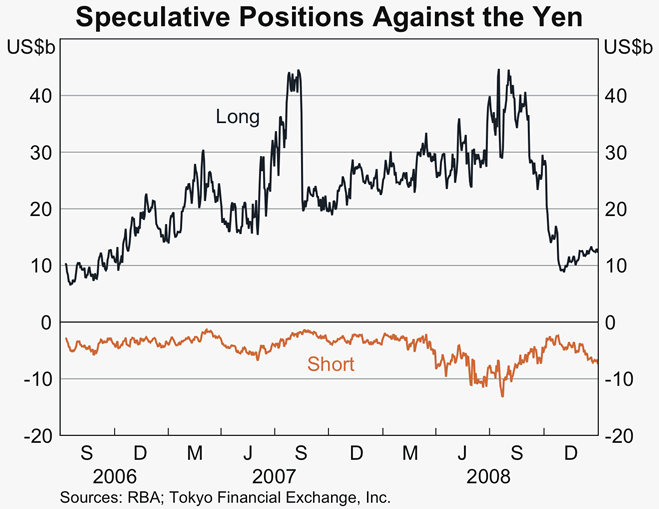
This overall pattern is exemplified by positions in the Australian dollar. Japanese retail investors have consistently taken net long positions in the Australian dollar against the yen since at least mid 2006 (Graph 5). The reductions in these net long positions in August 2007 and October 2008 coincided with sharp depreciations in the Australian dollar.
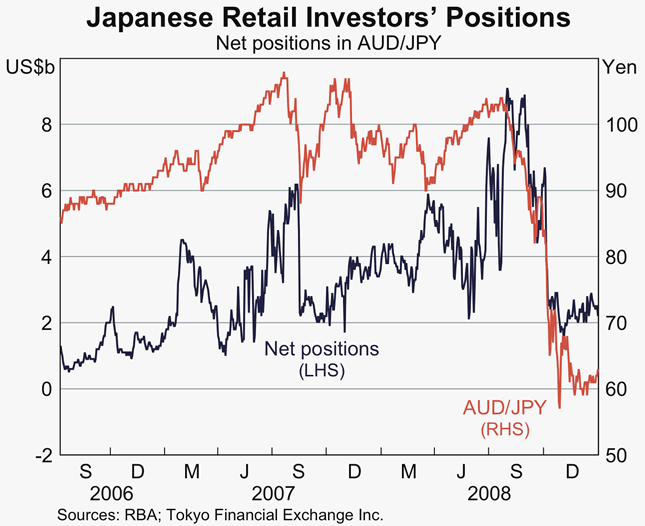
Looking at the net positions across the six largest currency pairs demonstrates that interest rate differentials are important in explaining the investment behaviour of Japanese retail foreign exchange investors (Graph 6). Comparing across currencies, the largest net long positions have been in the relatively high-interest-rate currencies, such as the Australian and New Zealand dollars, and the British pound, while net long positions in low-interest-rate currencies, notably the Swiss franc, have been small (indeed they have mostly taken net short positions in the Swiss franc). The largest net long positions over 2006 and 2007 were taken in the US dollar despite this trade offering an interest rate differential smaller than that offered by the other high-yielding currencies. This is likely to reflect a perception of lower risk associated with the USD/JPY trade. However, as the interest rate differential between the United States and Japan narrowed over the first half of 2008, net long positions in US dollar were reduced, and the Australian and New Zealand dollars became more favoured investment currencies, at least until the sharp increase in volatility in late 2008.
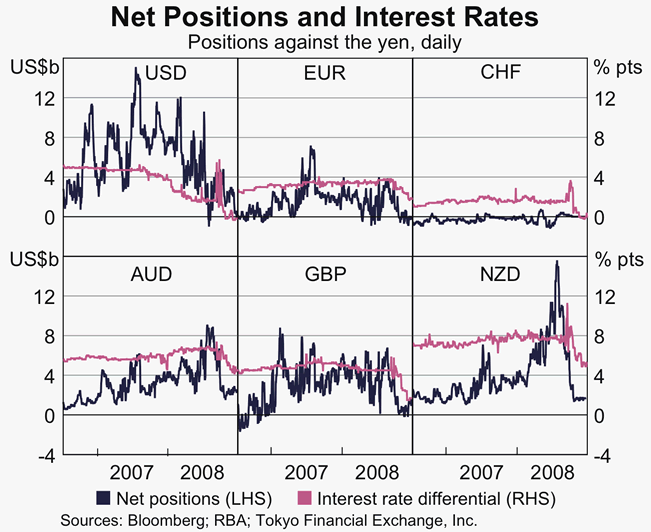
As discussed above, the carry trade is a risky strategy owing to the exposure to exchange rate movements, which can be large and sudden. Part of its popularity in recent years is likely to be related to the low volatility in exchange rates prior to the onset of the global financial crisis in late 2007. The reaction of the Japanese retail investors to the increase in financial market volatility (the VIX index measure of US equity market volatility is used as a proxy) was particularly apparent in October 2008 when investor positions were wound back sharply (Graph 7). Typically, these periods of increased volatility are associated with large exchange rate movements that more than offset the positive interest differential underlying carry trades. Since then Japanese retail investors have held only small net long positions. With perceptions of risk remaining high into the close of 2008, investors have been reluctant to increase exposure to the carry trade.
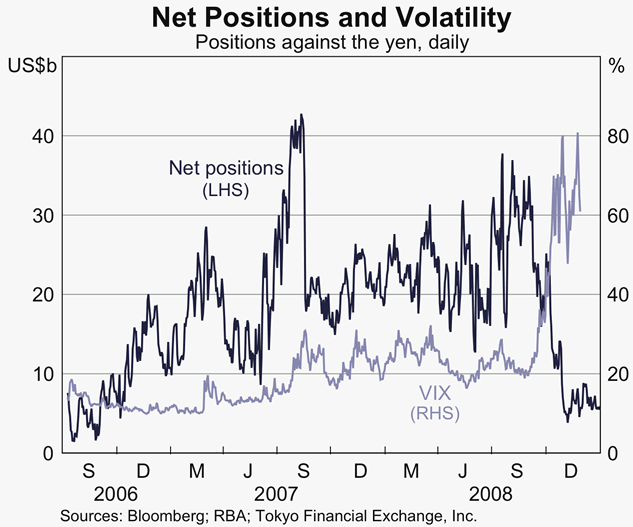
A scatter plot of daily changes in net positions against exchange rate movements indicates that Japanese retail investors tend to trade foreign currencies in a manner that is counter to momentum for moderately sized movements in exchange rates (Graph 8). Under the relatively stable exchange rate conditions that existed in the years prior to late 2007, retail investors on average increased their foreign currency net long positions when the investment currency depreciated and reduced these positions when the investment currency appreciated. This behaviour is consistent with realising returns by selling positions when the investment currency appreciates and adding to positions when the investing currency depreciates. As such, under conditions of low volatility Japanese retail investors exert a stabilising influence on exchange rates.
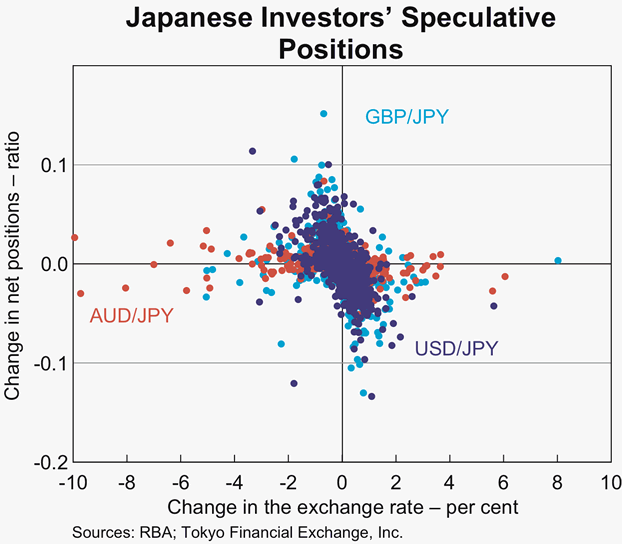
In this respect, the behaviour of Japanese retail investors contrasts with that of non-commercial (or ‘speculative’) traders on the CME. These speculative traders also appear to follow a carry trade strategy, displaying a strong tendency to short low-yielding currencies and take long positions in high-yielding currencies. However, in contrast to the Japanese retail investors, these investors typically decrease long positions in a high-yielding currency when that currency depreciates – that is, they tend to follow the short-term momentum in exchange rate movements (Graph 9). In this sense, CME speculative traders appear to follow a less pure carry strategy than Japanese retail investors. Moreover, CME speculative traders also appear to be relatively insensitive to the level of volatility in financial markets, neither reducing nor increasing their net positions in response to changes in the VIX.

As highlighted above, the stabilising behaviour of the Japanese retail investors changes when exchange rates move by an extreme amount during the day. This occurred on a few instances in October 2008, when there were large falls in high-yielding currencies against the yen (see Graph 5). On these occasions retail investors reduced their positions dramatically, probably adding to the downward momentum of the Australian dollar exchange rate on those days. This rapid unwinding of positions was likely driven by a combination of the investors' own stop-loss triggers and the aggregators issuing margin calls.
Profitability of Foreign Exchange Investors
The discussion in the first section of this article highlighted the variability in carry trade returns. Whether investors in the carry trade make a profit from the strategy in the long run depends heavily on the timing of trades. Calculating cumulative profits (following the methodology of Kearns and Manners 2004) from the TFX and CME data indicates that since 2006, Japanese retail investors in aggregate have suffered large losses while their CME speculative counterparts have earned significant profits on their foreign currency investments. This primarily reflects the fact that the CME speculative traders reacted more quickly to the sharp exchange rate depreciations that generated large carry trade losses for short periods in 2007 and 2008. In particular, the momentum-based trading strategy of CME speculative traders saw them – in aggregate – reduce their carry trade positions at the initial stage of the large depreciations in investment currencies (Graph 10). In contrast Japanese retail investors continued to put on net long positions in the Australian and New Zealand dollars just before they suffered large losses in August 2007 and more significantly in late 2008.

Summary
The results presented in this article provide support to anecdotal evidence that Japanese retail foreign exchange investors follow strategies based on a near-pure carry trade, and as such have suffered large and sudden losses that tend to occur after long periods of steady profitability. In stable conditions, Japanese retail margin traders tend to adjust their positions counter to the momentum of the exchange rate. However, when there are large unfavourable moves in exchange rates these investors tend to (or are forced to) liquidate long positions in investment currencies such as the Australian and New Zealand dollars. In contrast, it appears that CME speculative traders use momentum-based strategies and respond more swiftly to pronounced depreciations in investment currencies. As such, under conditions of low volatility, Japanese retail investors tend to help stabilise high-yielding currencies such as the Australian dollar. However, under more volatile conditions, they reinforce the momentum trading of the CME speculative traders. This was seen in late 2008 when Japanese retail investors significantly lowered their net long positions in response to the large depreciation in the Australian dollar.
References
Brunnermeier MK, S Nagel and LH Pedersen (2008), ‘Carry Trades and Currency Crashes’, NBER Working Paper No 14473.
Cairns J, C Ho and RN McCauley (2007), ‘Exchange Rates and Global Volatility: Implications for Asia-Pacific Currencies’, BIS Quarterly Review, March, pp 41–52.
Chinn MD and G Meredith (2004), ‘Monetary Policy and Long-Horizon Uncovered Interest Parity’, IMF Staff Papers, 51(3), pp 409–430.
Galati G, A Heath and P McGuire (2007), ‘Evidence of Carry Trade Activity’, BIS Quarterly Review, September, pp 27–41.
Kearns J and P Manners (2004), ‘The Profitability of Speculators in Currency Futures Markets’, RBA Research Discussion Paper No 2004-07.
Terada T, N Higashio and J Iwasaki (2008), ‘Recent Trends in Japanese Foreign-Exchange Margin Trading’, Bank of Japan Review, Report 2008-E-3, September.
Footnote
This article was prepared by Andrew Zurawski and Patrick D'Arcy of International Department. [1]